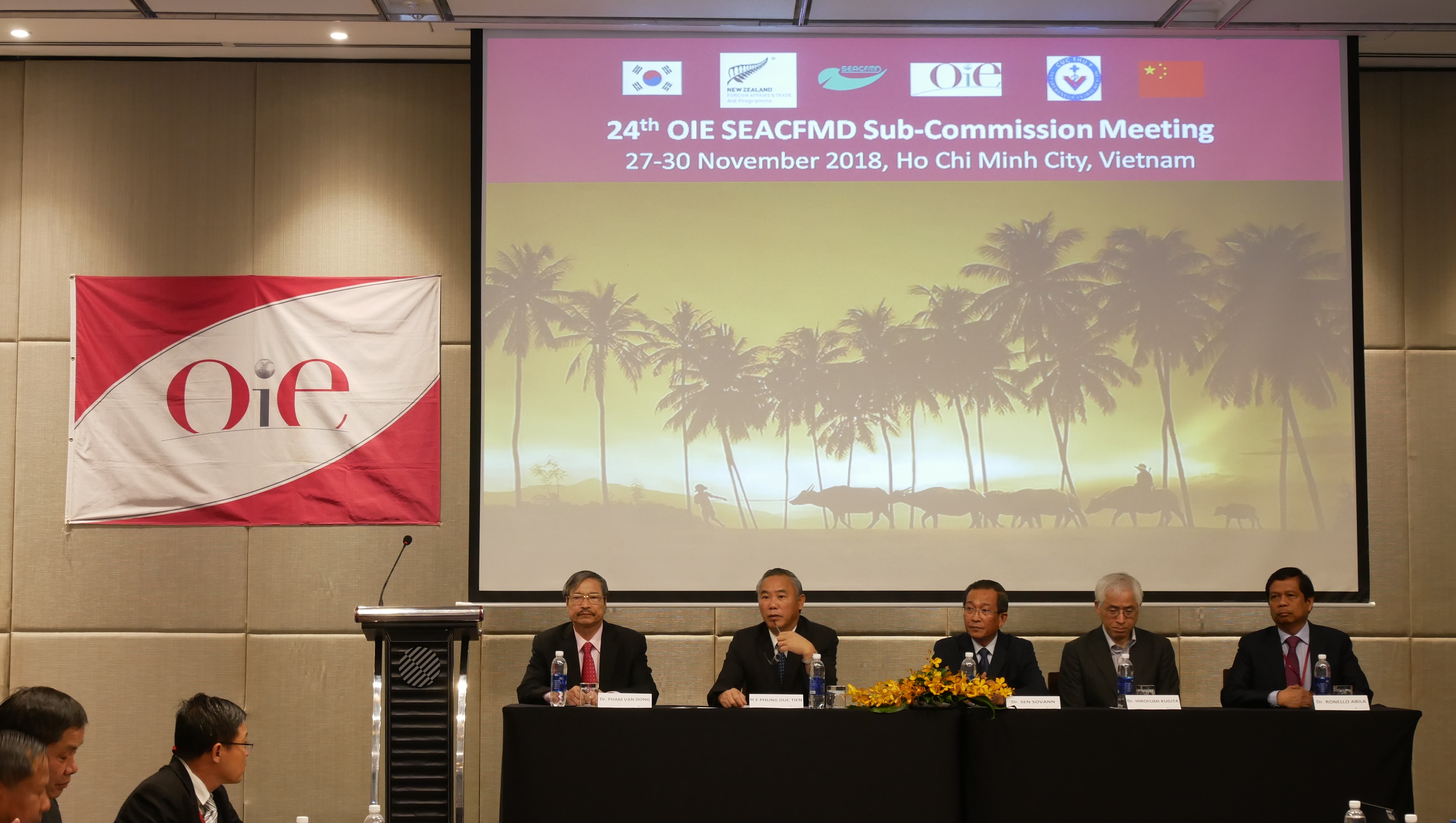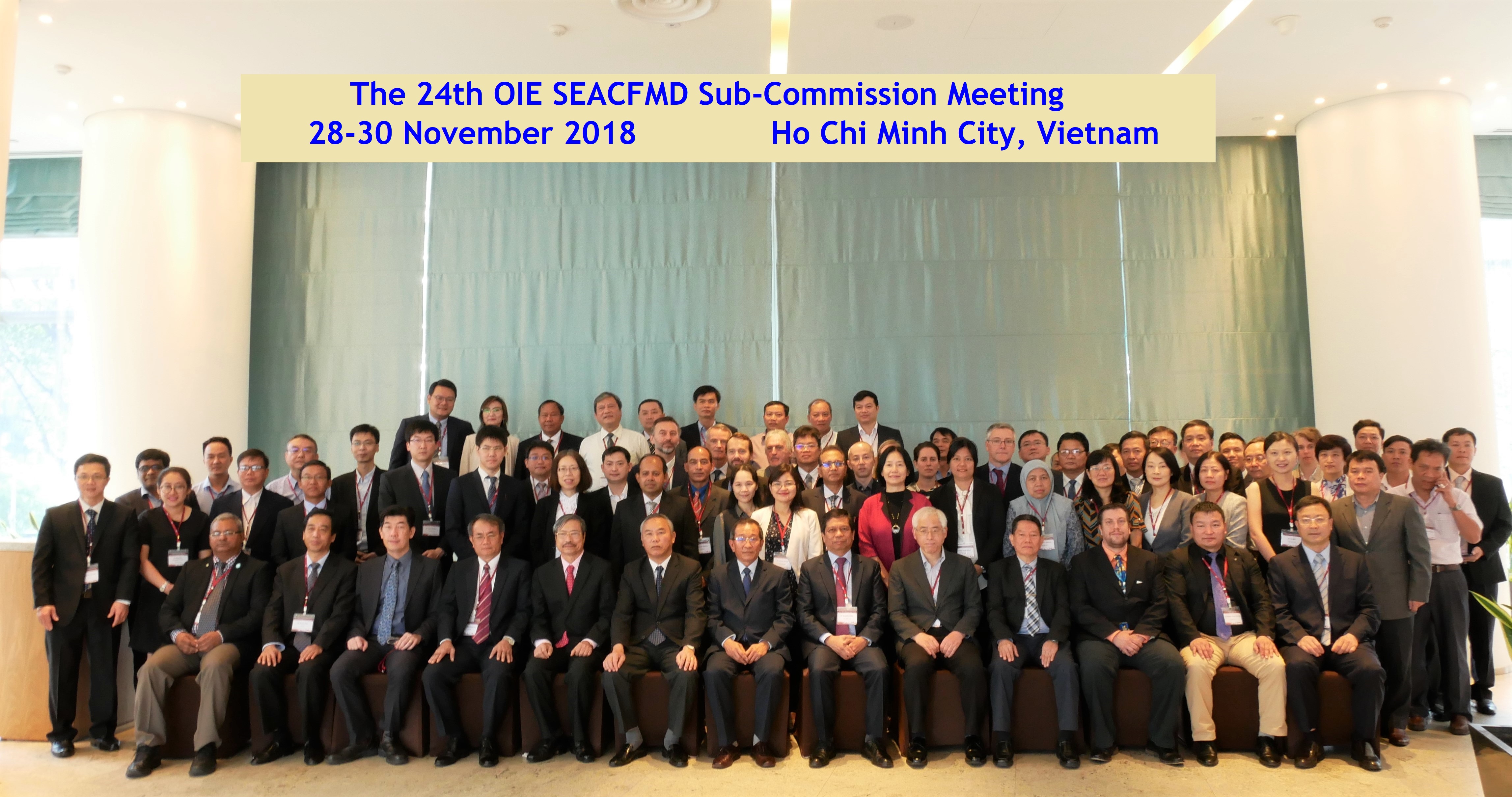The 24th Meeting of the OIE Sub-Commission for FMD in South-East Asia and China gathered around 80 participants, including national Delegates or their representatives of the SEACFMD Member Countries and neighbouring countries/territories, representatives of international organisations and private sectors, as well as FMD experts, observers and OIE staff from Regional Representation for Asia and the Pacific and Sub-Regional Representation for South-East Asia.
The Opening Ceremony was honoured by the presence of Mr Phung Duc Tien, vice-Minister of Agriculture and Rural Development of Vietnam, Dr Pham Van Dong, the OIE Delegate for Vietnam, Dr Sen Sovann, the OIE Delegate for Cambodia and the President of the OIE Regional Commission for Asia, the Far East and Oceania. Participants also appreciated the video message from Dr Monique Éloit, OIE Director General. After the opening ceremony, Vietnam, as the hosting country, was elected to be the new president of the SEACFMD Sub-Commission.
The meeting reviewed the recent changes in the OIE international standards relevant to FMD, including the extended concept of containment zone in Chapter 4.3 of the Terrestrial Animal Health Code, the newly adopted Chapter 4.17 on vaccination, the recently proposed changes in Chapter 1.4 on surveillance, and a new proposed chapter on official control of listed and emerging diseases. The OIE, with the support of the Delegate of Singapore, member of the OIE Council, encouraged members to be actively involved in providing comments on OIE Standards.
Subsequently, participants received updates on the latest global and regional FMD situation and challenges. The incursion and spread of an exotic FMDV strain O/ME-SA/Ind-2001 in the SEACFMD region were highlighted. Although no further outbreaks due to serotype Asia 1 were reported following the single detection in Myanmar in 2017, this risk of Asia 1 still exists given the continued outbreaks in South Asia and substantial unregulated cross-regional livestock movements. Another significant threat comes from the A/Asia/G-VII strain which has spread to multiple countries in West Eurasia. The meeting underlined the significant gap in FMD surveillance, e.g. the outbreaks reported annually by the SEACFMD Member Countries were far fewer than the thousands of outbreaks reported by the European countries during the FMD endemic period. This was at least partially attributed to the lack of incentives to report outbreaks and veterinary infrastructure to investigate and control outbreaks. Incentive programs and technical support to enhance FMD reporting and diagnosis would be highly needed to better understand the FMD situation in the region.
In the afternoon, plenary discussions on FMD control key issues were facilitated by the OIE staff or invited experts. The discussion topics included key factors for successful vaccination, animal movement monitoring and management, disease early reporting and detection, stakeholder engagement and communication tools, and policy and legislation. Short-term (2019-2020) and medium-term (2021-2025) priority actions were identified by participants during the discussion and completed through written questionnaires. Annex X summarises the key recommendations. that will be taken into account when developing the new SEACFMD Roadmap 2021-2025.
On the second day, selected Member Countries showcased good practices and experience learned in implementing the SEACFMD Roadmap. The participants noted that the regional FMD control was constrained by the mass unregulated animal movements, and that a coordinated movement management in the regional context taking into account the variable socio and animal production conditions between countries would be necessary.
Participants also received updates on FMD relevant activities from OIE Reference Laboratories for FMD in China and Thailand. Other key partners, including FAO Regional Representation, Veterinary Authorities of neighboring countries/territories, vaccine manufacturers and research institutes, shared their recent development on FMD research or prevention activities through oral or poster presentations. Participants were informed that the SEACFMD Research Priorities 2017-2020 was available on the OIE SRR’s website (http://www.rr-asia.oie.int/fileadmin/SRR_Activities/documents/SEAFMD-Regional_SEACF2018_Priorities.pdf), which could be used to guide the development a research proposal on FMD as well as an advocacy document for applying FMD research grant funding.
In the end of the meeting, the SEACFMD campaign priorities and action plan for 2019/2020 were reviewed. The meeting concluded with key recommendations which will serve as a guideline for the SEACFMD Campaign’s work in the following years. The discussions were fruitful, and the recommendations adopted during the meeting will be submitted to the Regional Commission Meeting in November 2019 for endorsement

